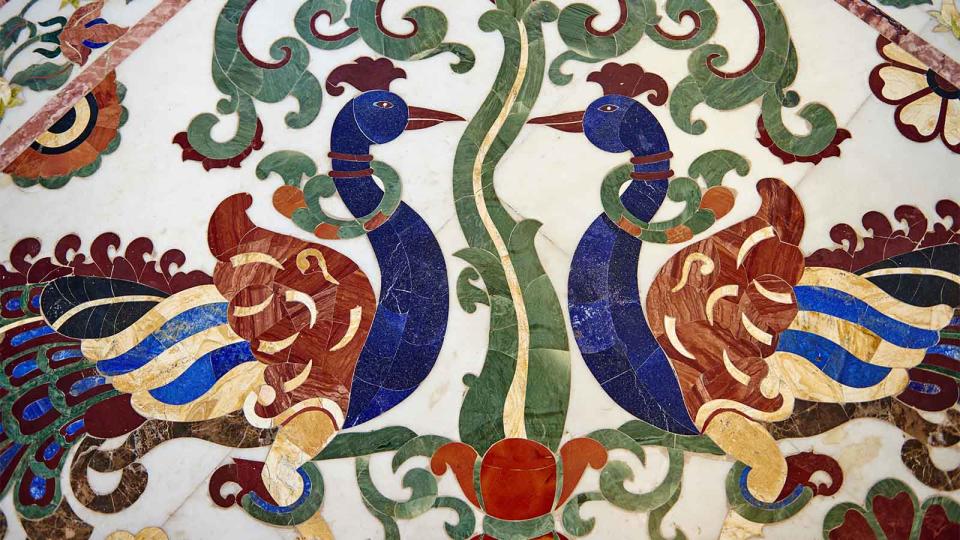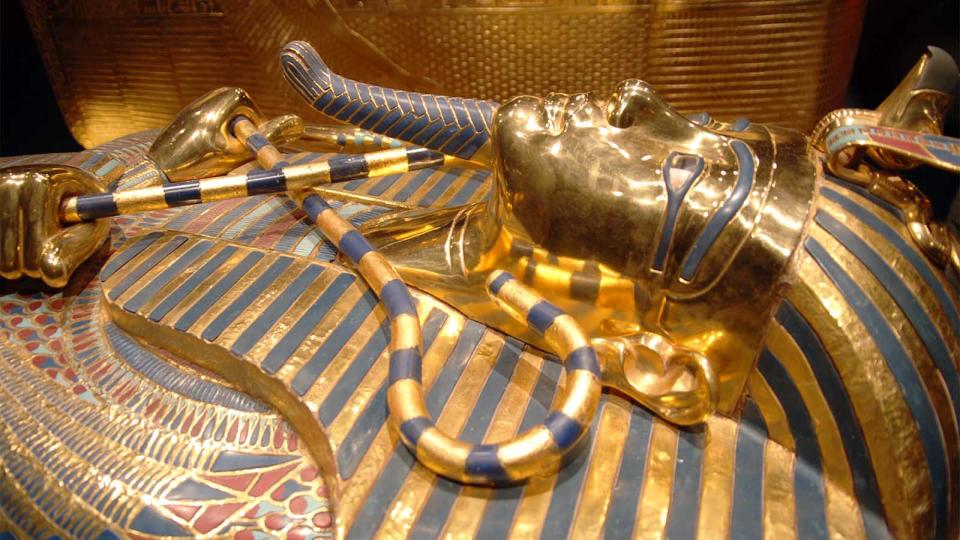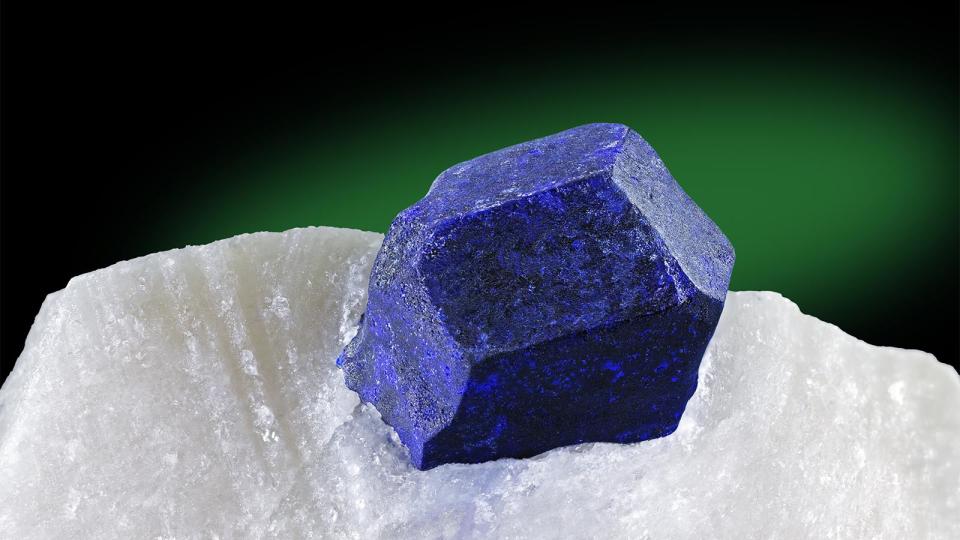Lapis Lazuli: Crystal Properties, Origins and Uses

The lapis lazuli crystal is a prized material that has been used to adorn great works of art, from pharaohs' coffins to the Sistine Chapel. It can also be found on King Tut's coffin and other funeral items, and it's also touted for its connection to "cosmic wisdom".
In crushed form, it became the bluest blue in an artist's palette — ultramarine — and was so expensive that Michelangelo couldn't afford it. Lapis lazuli's rarity and intense blue color, along with its use in creating ultramarine pigment, contributed to its high value in history.
Today, we may attach a high value to diamonds and rubies, but for centuries, lapis lazuli stones were the precious stones that ruled the sky and the seas.
What Is a Lapis Lazuli Crystal?
"Lapis lazuli is actually a rock, and a lot of people don't realize that," says McKenzie Santimer, manager of Gemological Institute of America's (GIA) Museum and exhibit designer.
Its identity as a rock means that it is an aggregate of three minerals or more. In the case of lapis lazuli, those three minerals are lazurite, calcite and pyrite. Lazurite is responsible for the blue color, calcite for the white veining and pyrite for the flashy, sparkly bits.
The name comes from Latin for rock, which is "lapis," and lazuli is derived from the Arabic and Persian word for the place the stone was mined. The Persian word "lāzhward" became Arabic "(al-) lazward" and Latin "lazulum." These names, associated with the stone, later led to the words for blue in languages like Spanish and Italian.
This deep blue stone ranks a 5.5 on the Mohs Hardness Scale, which is about the same as window glass. (Diamonds are the hardest at 10, and talc is softest with a hardness of 1.)
That means lapis crystals are porous and relatively soft, but also still durable. Their features allow them to be carved easily, but they can be scratched easily too.

Where Does the Lapis Lazuli Crystal Come From?
The legendary home of lapis lazuli is Afghanistan, Santimer explains. Specifically, the Badakhshan area is home to the best lapis.
According to New World Encyclopedia, the ancient Egyptians and ancient Sumerians and Babylonians had lapis lazuli imported from these mines, possibly the world's oldest. Lapis lazuli was also used in ancient Egypt to adorn items like pharaoh's masks, scarabs and beads. It was a prominent feature in King Tutankhamun's two coffins.
Santimer says that historically — and still today — the most prized lapis comes from that location. However, unlike the ancients, contemporary popular localities also include Russia, China and Chile. The American Gem Trade Association lists Myanmar, as well, where lapis lazuli deposits are mined today.

Why Was Lapis Lazuli Treasured by Ancient Civilizations?
Lapis lazuli turned heads with its brilliant color, plus it was easy to make it look good through polishing and carving, Santimer explains. "It's one of the older gemstones around," she says, predating the discovery of others we might consider more precious today.
Ancient civilizations may have associated blue with the sky and heavens, which alludes to the afterlife. Lapis lazuli is believed by some to have metaphysical properties and used to be valued and traded because its royal blue color was godlike.
"If this wild, blue color came from the gods, you are going to go seek it," says Santimer.
But in addition to being used on pharaoh's masks, it is rumored that pulverized lapis lazuli was the eyeshadow of choice for Cleopatra.
During that medieval period, the pigment — a color named ultramarine, which means "beyond the sea" — was "more precious than gold," Ravi Mangla wrote in The Paris Review. It was so special and expensive, ultramarine was usually reserved for special commissions or parts of paintings like the Virgin Mary's robes.
Until the 19th century, lapis lazuli was the only game in town for "true blue" ultramarine. But in the 1820s, French chemist Jean-Baptiste Guimet created a synthetic alternative to real lapis lazuli.
Lapis Lazuli Healing Properties
In addition to its visually attractive qualities, some believe that wearing lapis lazuli benefits the respiratory and nervous systems. It's thought to reduce inflammation, promote healing and help identify "the karmic roots of disease," according to Crystals and Holistic Healing.
Although GIA does not study or qualify healing properties of gems and rocks, Santimer did provide a word of caution.
"A gem should not be ingested," she says. "They should be worn, adorned and not eaten."

How Do People Use Lapis Lazuli Today?
Medieval artists used lapis lazuli for precious ultramarine paint, but it has had many additional purposes. For example, the Greeks used it on caskets, shrines and sculptures, and the Chinese carved it into objects like game boards, dagger handles, hair combs and amulets, says Santimer. Church wall panels, massive inlays, sculptures and mosaics were also made of lapis lazuli.
These are historical examples, but they are still ways that the stone is used today — as sculpture, jewelry, objets d'art and mosaics. You can still buy lapis lazuli pigments too. It's never gone out of style.
"There aren't that many blue gemstones, so this is definitely a prized one," says Santimer. More saturated blue with less veining and less pyrite carries a higher value. "The highly prized material out of Afghanistan can be very expensive."
If you would like to invest in this prized rock, you need to take care of it like any gem. Although lapis is found in rings, beads and many styles of jewelry, keep in mind that it can be easily damaged due to its softness.
Don't wear lapis lazuli jewelry while doing housework or participating in heavy activity, Santimer advises. And keep it protected from solvents. If you need to cleanse lapis lazuli, warm water and dish soap will work just fine.
Now That's Interesting
In a myth dating from around 4000 B.C.E., the Sumerian goddess of love, Inanna, is said to have entered the underworld with a necklace and rod of lapis lazuli.
This article was updated in conjunction with AI technology, then fact-checked and edited by a HowStuffWorks editor.
Original article: Lapis Lazuli: Crystal Properties, Origins and Uses
Copyright © 2023 HowStuffWorks, a division of InfoSpace Holdings, LLC, a System1 Company

